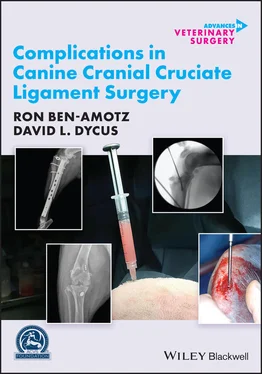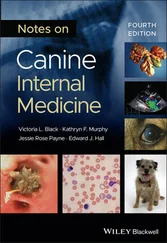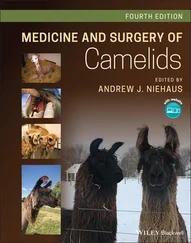1 Cover
2 Title Page
3 Copyright Page
4 Preface
5 List of Contributors
6 Foreword
7 Acknowledgments
8 Disclosures
9 Section I: Introduction 1 Pathology, Diagnosis, and Treatment Goals of Cranial Cruciate Ligament Rupture and Defining Complications 1.1 Introduction 1.2 Diagnosis 1.3 Treatment 1.4 Defining a Complication References 2 Surgeon and Patient Preparation to Minimize Surgical Site Complications and Infection Surveillance Programs 2.1 Introduction 2.2 Host Factors 2.3 Environmental Factors 2.4 Surgical Procedure 2.5 Antimicrobial Use 2.6 Surveillance 2.7 Conclusion References 3 Identification, Addressing, and Following Up on Surgical Site Infection After Cranial Cruciate Ligament Stabilization 3.1 Introduction 3.2 Identification of Surgical Site Infections 3.3 Addressing Surgical Site Infections 3.4 Follow‐Up References
10 Section II: Intraarticular Repair Techniques 4 Complications Associated with Intraarticular Repair Techniques 4.1 An Introduction to Intraarticular Repair in Veterinary Medicine 4.2 Intraarticular Repair Complications in Humans 4.3 Intraarticular Repair Complications in Canines 4.4 Graft Selection 4.5 Tunnel Creation 4.6 Graft Fixation 4.7 Intraarticular Repair Assessment and Revision 4.8 Conclusion 4.9 Clinical Examples References 5 Complications Associated with Proximal Tibial Epiphysiodesis 5.1 Introduction 5.2 Identification of Potential Complications 5.3 Preoperative Planning Strategies 5.4 Surgical Technique 5.5 Identification and Correction of Intraoperative Complications 5.6 Evaluation and Identification of Postoperative Complications 5.7 Decision Making for Postoperative Complications 5.8 Revision Strategies for Postoperative Complications 5.9 Key Points References
11 Section III: Extraarticular Repair Techniques 6 Extracapsular Stabilization Using Synthetic Material 6.1 Introduction 6.2 Preoperative Patient Classification and Suitability for Extracapsular Suture Procedure 6.3 Preoperative Planning Strategies to Minimize Complications both Intra‐operatively and Post‐operatively 6.4 Operative Features of Extracapsular Suture 6.5 Placement of Implant: Femoral and Tibial Insertion Sites and Options 6.6 Choice of Synthetic Material (Monofilament, Multifilament) 6.7 Prefatigue and Tensioning of Material 6.8 Method of Securing the Material 6.9 Intraoperative Contamination and Avoidance Strategies 6.10 Soft Tissue Plane(s) Closure and Material Used 6.11 Identification of Intraoperative Complications 6.12 Evaluation and Identification of Immediate Post‐operative Complications 6.13 Evaluation and Identification of Delayed, Midterm Post‐operative Complications 6.14 Evaluation and Identification of Long‐Term Post‐operative Complications 6.15 Conclusion Contributors References 7 Complications Associated with Extracapsular Stabilization Using Monofilament Material 7.1 Introduction 7.2 History of Lateral Extracapsular Suture 7.3 Patient Selection Considerations for Lateral Extracapsular Suture 7.4 Preoperative Planning Tips to Minimize Complications 7.5 Intraoperative Technical Considerations, Complications, and Revision Strategies 7.6 Tips to Prevent Intraoperative Complications 7.7 Identification and Management of Postoperative Complications 7.8 Tips to Prevent Postoperative Complications 7.9 Conclusion References 8 Complications Associated with Extracapsular Stabilization using Multifilament Material 8.1 Introduction 8.2 Preoperative Planning 8.3 Intraoperative Procedure 8.4 Postoperative Considerations 8.5 Conclusion References
12 Section IV: Osteotomy Repair Techniques 9 Complications Associated with Cranial Closing Wedge Osteotomy 9.1 Introduction 9.2 Preoperative Planning 9.3 Intraoperative Complications 9.4 Postoperative Complications References 10 Complications Associated with Tibial Plateau Leveling Osteotomy 10.1 Introduction 10.2 Literature Review of Complications 10.3 Complications Specific to Tibial Plateau Leveling Osteotomy: Tips to Minimize Complications 10.4 Return to Function References 11 Complications Associated with CORA‐Based Leveling Osteotomy 11.1 Introduction 11.2 Literature Review of Complications 11.3 Complications Specific to CORA‐Based Leveling Osteotomy 11.4 Tips to Minimize Complications References 12 Complications Associated with Tibial Tuberosity Advancement 12.1 Introduction 12.2 Intraoperative Complications 12.3 Postoperative Complications – Overall Frequency 12.4 Postoperative Complications – Minor 12.5 Postoperative Complications – Major 12.6 Risk Factors for Postoperative Complications 12.7 Conclusion References 13 Complications Associated with the Modified Maquet Technique 13.1 History 13.2 Guidelines to Perform a Modified Maquet Technique 13.3 Specific Complications 13.4 Relevant Literature References
13 Section V: Nonsurgical Management and Physical Rehabilitation 14 Complications Associated with Stifle Orthotics 14.1 Introduction 14.2 Stifle Orthoses Construction 14.3 Stifle Orthoses and Owner Perception 14.4 Stifle Orthoses and Weight Bearing 14.5 Stifle Orthoses and Cranial‐Caudal Translation 14.6 Stifle Orthoses and Joint Rotation 14.7 Stifle Orthoses and the Impact on Adjacent Joints 14.8 Clinical Complications during Orthotic Usage 14.9 Conclusion References 15 Complications from Cranial Cruciate Ligament Surgery 15.1 Introduction 15.2 Gait Evaluation 15.3 Surgical Limb Evaluation 15.4 Range of Motion Evaluation 15.5 Meniscal Evaluation 15.6 Muscle Strength Evaluation 15.7 Choice of Modalities 15.8 Communication to Minimize Complications References
14 Section VI: Adjunctive Information 16 Complications Associated with Feline Cranial Cruciate Ligament Techniques 16.1 Introduction 16.2 Anatomy 16.3 Cranial Cruciate Ligament Rupture 16.4 Meniscal Injury 16.5 Tibial Plateau Angle Measurement 16.6 Management Considerations 16.7 Extracapsular Stabilization 16.8 Osteotomy for Cranial Cruciate Ligament Rupture in the Cat: Considerations 16.9 Tibial Plateau Leveling Osteotomy 16.10 Tibial Tuberosity Advancement 16.11 Multiligamentous Stifle Injuries/Stifle Disruption References 17 Complications Associated with Arthroscopic Evaluation of the Stifle and Decision Making 17.1 Introduction 17.2 Preoperative Considerations and Complications 17.3 Intraoperative Considerations and Complications 17.4 Postoperative Considerations and Complications 17.5 Decision Making with Arthroscopy: Short‐Term Implications 17.6 Decision Making with Arthroscopy: Long‐Term Implications References 18 Complications Associated with the Meniscus and Decision Making 18.1 Introduction 18.2 Preoperative Meniscal Evaluation 18.3 Exposure of the Meniscus and Diagnosis of Meniscal Tears 18.4 Meniscal Treatment 18.5 Lateral Meniscal Tears 18.6 Postoperative Meniscal Complications References
15 Index
16 End User License Agreement
1 Chapter 2 Table 2.1 Surgical procedure classification. Table 2.2 Halstead's principles. Table 2.3 American society of anesthesiologists (ASA) scores.
2 Chapter 3 Table 3.1 Swabbing techniques. Table 3.2 Surgical site infection (SSI) definitions. Table 3.3 Pros and cons of implantable antimicrobial elution products.
3 Chapter 5Table 5.1 Demographic data from 24 cases of PTE by one author (AV) showing th...
4 Chapter 9Table 9.1 Planned wedge angles based on preoperative tibial plateau angle (TP...
5 Chapter 12Table 12.1 Summary of publications which report complications associated with...
6 Chapter 13Table 13.1 Calculation of the osteotomy length in function of the desired TTA...Table 13.2 Calculation of bone hinge thickness in function of patient body we...
7 Chapter 15Table 15.1 Complications after surgical stabilization of cranial cruciate lig...Table 15.2 Example of a 0–V numerical rating scale for subjective assessment ...Table 15.3 Mean ± standard deviation flexion and extension of the stifle join...
Читать дальше












